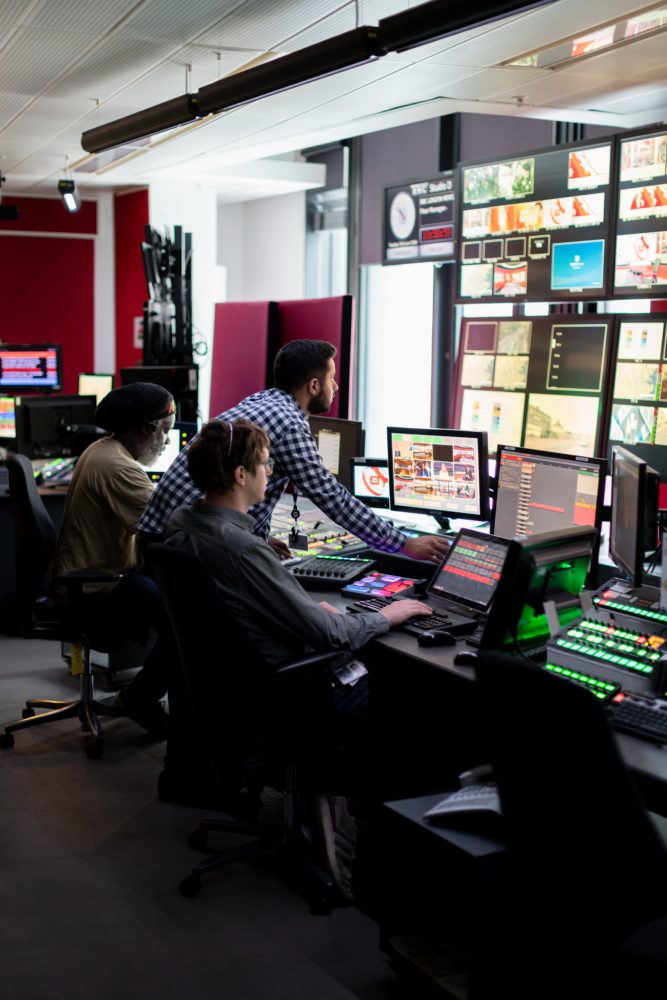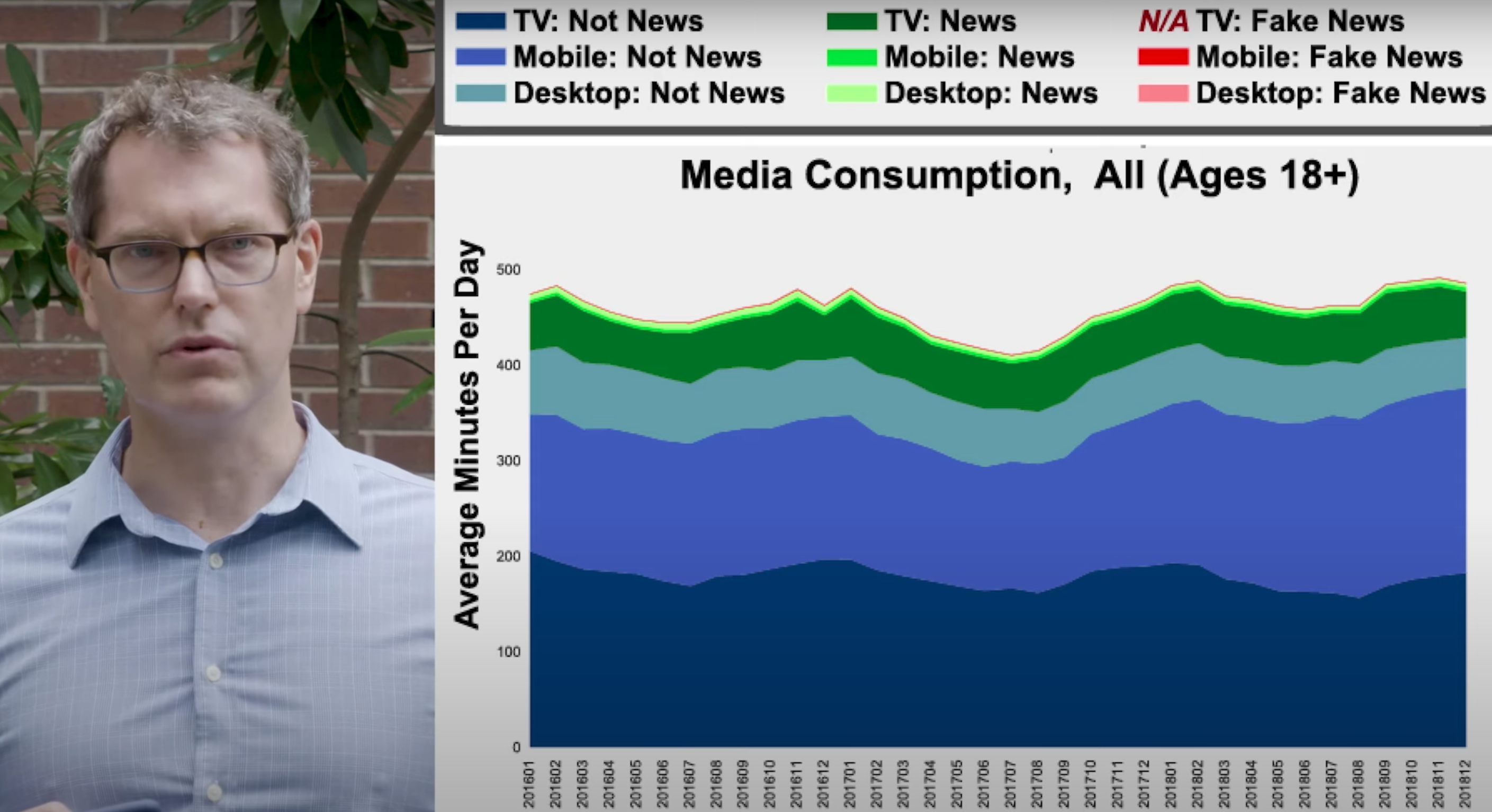
Fake news’ potent impact may be… fake news
Television dominates news consumption in the United States. (Photo by ThisisEngineering RAEng on Unsplash)
How much “fake news” are people consuming? Less than you might think, says one scholar.
A social scientist known for his study of information networks and relationships has taken a hard look at so-called “fake news” and concluded that it is not as widespread as some people believe. In a pre-recorded talk delivered online to journalists attending ScienceWriters2020 Oct. 19–23, Duncan Watts said his research suggests that misinformation and public polarization are bigger contributors to public opinion than outright fabricated news.
“Even though [Americans] consume a lot of media content every day on average, only about 14% is news of any sort,” Watts said in an interview. Most of that comes from network and cable television. Using data gathered and curated by Nielson and Comscore, which track TV and digital programming, Watts said even 14% is a “generous estimate” of overall news consumption, given that his team included late-night comedy in defining “news” for their analysis. Watts, a sociologist, is Stevens University Professor at the University of Pennsylvania.
He estimates that, on average, fake news—defined as deliberately fabricated stories—comprises less than one percent of news consumption and takes up less than a minute of a person’s day at most. Certainly minutes accumulate, and some social media users are more exposed to fake news than others. But “if you think that fake news is this terrible problem,” Watts said, “you have to convince yourself that this tiny fraction is so potent that it’s overwhelming everything else out there.”

For his research, Watts relied on data drawn from daily media consumption on American’s desktop, mobile, and television devices over the course of three years. Fake news consumption time was defined as daily minutes spent on sources identified as deceptive. Some platforms, including YouTube and Twitter, were excluded from the database because identifying news commentary on those platforms requires complicated text parsing. Of the more than 400 minutes of media consumption per day among users on average, fake news took up just a few seconds of Americans’ daily attention.
Editorial decisions: Still the biggest influence in political news
Watts said his team found that misleading editorial emphasis plays a bigger role in misinformation than outright lies. For example, in the two months before the 2016 presidential election, The New York Times ran as many front-page stories about Hilary Clinton’s private email server as they did about all policy issues. While the stories were not fake, their frequency and placement emphasis misled the public about their role and meaning in the context of all political news at the time. Foreign hacks and political extremists were not the main source of this news, but rather professional journalists writing for mainstream news organizations were.
As a loyal subscriber to the Times, Watts believes the newspaper does a lot of good. But “because they mean well doesn’t mean that they don’t cause problems,” he said, “or that the problems they cause don’t have as much power” as actual fake news.
Journalists and other news producers think of themselves as objective observers of events simply describing what’s happening to their audiences. In reality, Watts said, it’s the choice of particular types of stories and decisions about how much coverage the stories receive that mold public opinion. For example, the Times coverage of Clinton’s emails suggested to their readers that she couldn’t be trusted. “There are all kinds of ways that the media creates impressions of the world, whether it’s an ‘agenda’ or not,” Watts said, adding that decisions aren’t necessarily malfeasance, or intentional efforts to misinform.
Watts previously worked for Microsoft and has written extensively about “small world” networks and the common errors people make in interpreting information and making decisions. He sees parallels between the ways journalism and science publications can mislead.
Many research studies described in reputable journals are not repeatable, he noted, calling into question the validity of the research method itself. Non-objective statements that may shape public opinion trouble both scientists and journalists because they call into question “facts” and “truth.” If researchers and reporters don’t come to grips with such behavior, he said, “there is a risk of degenerating into a state where science is just another opinion.” Certainly some bad scientists consciously falsify data, but as with fake news in journalism, that accounts for very little compared to the amount of content created.
When misinformation rather than outright lying corrodes public understanding, careful stock of subconscious assumptions and agendas need to be considered before publishing content. “Objectivity is tough,” Watts admitted. Digging into the decisions that both scientists and journalists make in their data or story analysis sometimes means “realizing that a lot of stuff is less solid than it seems.” However, he maintains that we should remain hopeful. The purpose of critiquing and reframing stories in science and journalism, despite being difficult, “is not hopeless and in fact, we’re very committed to trying to make things better.”
Watts discussed his research as part of the New Horizons in Science briefings presented by the Council for the Advancement of Science Writing during ScienceWriters2020, a virtual conference co-organized by CASW and the National Association of Science Writers.